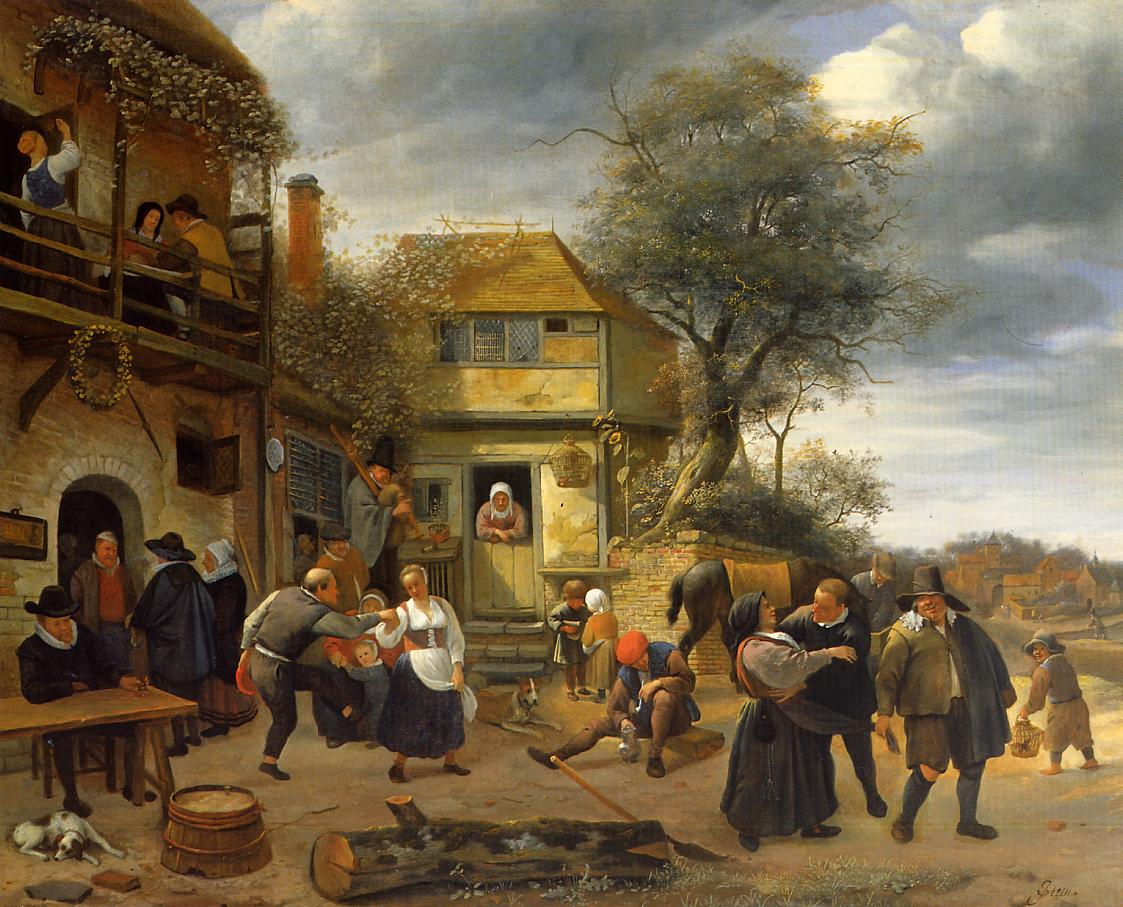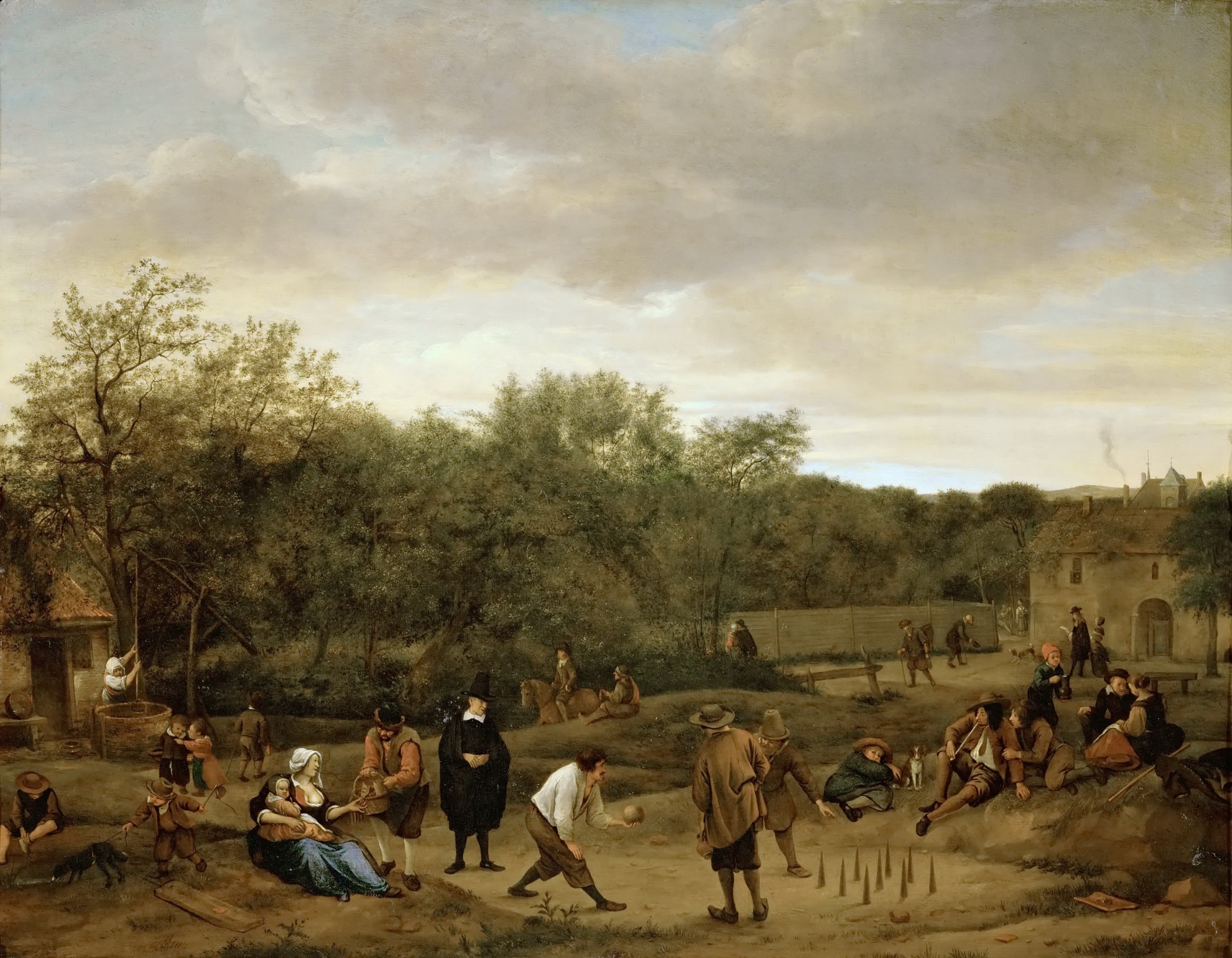Jan Havickszoon Steen on:
[Wikipedia]
[Google]
[Amazon]
Jan Havickszoon Steen (c. 1626 – buried 3 February 1679) was a


 Steen was born in
Steen was born in
Dutch Golden Age painter
Dutch Golden Age painting is the painting of the Dutch Golden Age, a period in Dutch history roughly spanning the 17th century, during and after the later part of the Eighty Years' War (1568–1648) for Dutch independence.
The new Dutch Repub ...
, one of the leading genre painter
Genre painting (or petit genre), a form of genre art, depicts aspects of everyday life by portraying ordinary people engaged in common activities. One common definition of a genre scene is that it shows figures to whom no identity can be attached ...
s of the 17th century. His works are known for their psychological insight, sense of humour and abundance of colour.
Life

 Steen was born in
Steen was born in Leiden
Leiden (; in English and archaic Dutch also Leyden) is a city and municipality in the province of South Holland, Netherlands. The municipality of Leiden has a population of 119,713, but the city forms one densely connected agglomeration wit ...
, a town in Southern Holland, where his well-to-do, Catholic family were brewers who ran the tavern ''The Red Halbert'' for two generations. Steen's father even leased him a brewery of his own in Delft from the years 1654 until 1657. He was the eldest of eight or more children. Like his even more famous contemporary Rembrandt van Rijn
Rembrandt Harmenszoon van Rijn (, ; 15 July 1606 – 4 October 1669), usually simply known as Rembrandt, was a Dutch Golden Age painter, printmaker and draughtsman. An innovative and prolific master in three media, he is generally consid ...
, Jan Steen attended the Latin school
The Latin school was the grammar school of 14th- to 19th-century Europe, though the latter term was much more common in England. Emphasis was placed, as the name indicates, on learning to use Latin. The education given at Latin schools gave gre ...
and became a student in Leiden. Though no official records of Steen's artistic training are preserved, contemporary sources tell us he received his painterly education from three men, Nicolaes Knupfer (1603–1660), a German painter of historical and figurative scenes in Utrecht
Utrecht ( , , ) is the List of cities in the Netherlands by province, fourth-largest city and a List of municipalities of the Netherlands, municipality of the Netherlands, capital and most populous city of the Provinces of the Netherlands, pro ...
, Adriaen van Ostade
Adriaen van Ostade (baptized as Adriaen Jansz Hendricx 10 December 1610 – buried 2 May 1685) was a Dutch Golden Age painter of genre works, showing everyday life of ordinary men and women.
Life
According to Arnold Houbraken, he and his brot ...
, and Jan van Goyen
Jan Josephszoon van Goyen (; 13 January 1596 – 27 April 1656) was a Dutch landscape painter. The scope of his landscape subjects was very broad as he painted forest landscapesm marines, river landscapes, beach scenes, winter landscape, cityscap ...
, who would later become his father-in-law. Influences of Knupfer can be found in Steen's use of composition and colour. Another source of inspiration was Isaac van Ostade
Isaac van Ostade (bapt. June 2, 1621 – buried October 16, 1649) was a Dutch genre and landscape painter.
Biography
Van Ostade was born in Haarlem. He began his studies under his brother, Adriaen, with whom he remained until 1641, when he s ...
, a painter of rural scenes, who lived in Haarlem
Haarlem (; predecessor of ''Harlem'' in English) is a city and municipality in the Netherlands. It is the capital of the province of North Holland. Haarlem is situated at the northern edge of the Randstad, one of the most populated metropoli ...
.
In 1648 Jan Steen and Gabriël Metsu
Gabriël Metsu (1629–1667) was a Dutch painter of history paintings, still lifes, portraits, and genre works. He was "a highly eclectic artist, who did not adhere to a consistent style, technique, or one type of subject for long periods". On ...
founded the painters' Guild of Saint Luke
The Guild of Saint Luke was the most common name for a city guild for painters and other artists in early modern Europe, especially in the Low Countries. They were named in honor of the Evangelist Luke, the patron saint of artists, who was ide ...
at Leiden. Soon after he became an assistant to the renowned landscape painter Jan van Goyen
Jan Josephszoon van Goyen (; 13 January 1596 – 27 April 1656) was a Dutch landscape painter. The scope of his landscape subjects was very broad as he painted forest landscapesm marines, river landscapes, beach scenes, winter landscape, cityscap ...
(1596–1656), and moved into his house on the Bierkade in The Hague
The Hague ( ; nl, Den Haag or ) is a city and municipality of the Netherlands, situated on the west coast facing the North Sea. The Hague is the country's administrative centre and its seat of government, and while the official capital of ...
. On October 3, 1649, he married van Goyen's daughter Margriet, with whom he would have eight children. Steen worked with his father-in-law until 1654, when he moved to Delft
Delft () is a List of cities in the Netherlands by province, city and Municipalities of the Netherlands, municipality in the Provinces of the Netherlands, province of South Holland, Netherlands. It is located between Rotterdam, to the southeast, ...
, where he ran the brewery ''De Slang'' ("The Snake") for three years without much success. After the explosion in Delft in 1654 the art market was depressed, but Steen painted ''A Burgomaster of Delft and his daughter''. It does not seem to be clear if this painting should be called a portrait or a genre work.
Steen lived in Warmond
Warmond () is a village and former municipality in the Western Netherlands, north of Leiden in the province of South Holland. The municipality covered an area of 14.42 km² (5.57 mile², 30.7%) of which 4.42 km² (1.71 mile²) is water; ...
, just north of Leiden, from 1656 till 1660 and in Haarlem
Haarlem (; predecessor of ''Harlem'' in English) is a city and municipality in the Netherlands. It is the capital of the province of North Holland. Haarlem is situated at the northern edge of the Randstad, one of the most populated metropoli ...
from 1660 till 1670 and in both periods he was especially productive. In 1670, after the death of his wife in 1669 and his father in 1670, Steen moved back to Leiden, where he stayed the rest of his life. When the art market collapsed in 1672, called the Year of Disaster, Steen opened a tavern. In April 1673 he married Maria van Egmont, who gave him another child. In 1674 he became president of the Saint Luke's Guild. Frans van Mieris (1635- 1681) became one of his drinking companions. He died in Leiden in 1679 and was interred in a family grave in the Pieterskerk.
Influences
Connection with the ''Rederijkers''
In 1945,Sturla Gudlaugsson
Sturla Gudlaugsson (1913 – 1971) was a Danish-born Dutch art historian and director of the RKD and the Mauritshuis in The Hague.
Gudlaugsson was born in Skagen as the son of the Icelandic poet Jonas Gudlaugsson, but his father died when he was ...
, a specialist in Dutch seventeenth-century painting and iconography and Director of the Netherlands Institute for Art History and the Mauritshuis
The Mauritshuis (; en, Maurice House) is an art museum in The Hague, Netherlands. The museum houses the Royal Cabinet of Paintings which consists of 854 objects, mostly Dutch Golden Age paintings. The collection contains works by Johannes Vermeer ...
in The Hague, wrote ''The Comedians in the work of Jan Steen and his Contemporaries'', which revealed that a major influence on Jan Steen's work was the guild of the Rhetoricians or ''Rederijkers'' and their theatrical endeavors.
It is often suggested that Jan Steen's paintings are a realistic portrayal of Dutch 17th-century life. However, not everything he did was a purely realistic representation of his day-to-day environment. Many of his scenes contain idyllic and bucolic fantasies and a declamatory emphasis redolent of theater.
Jan Steen's connection to theater is easily verifiable through his connection to the ''Rederijkers''. There are two kinds of evidence for this connection. First, Jan Steen Steen's uncle belonged to the Rhetoricians in Leiden, where Steen was born and lived a substantial part of his life. Second, Jan Steen portrayed many scenes from the lives of the ''Rederijkers'', an example being the painting ''Rhetoricians at a Window'' of 1658–65. The piece is currently held in the Philadelphia Museum of Art
The Philadelphia Museum of Art (PMoA) is an art museum originally chartered in 1876 for the Centennial Exposition in Philadelphia. The main museum building was completed in 1928 on Fairmount, a hill located at the northwest end of the Benjamin Fr ...
which was established in February 1876. The humanity, humour and optimism of the figures suggest that Jan Steen knew these men well, and wanted to portray them positively.
Theater
With his lavish and moralising style, it is logical that Steen would employ the stratagems from theater for his purposes. There is conclusive evidence that the characters in Steen's paintings are predominantly theatrical characters and not ones from reality. Steen's numerous paintings of a theme most commonly entitled ''The Doctor's Visit'', such as the composition of 1665–70 in the Rijksmuseum, illustrate his theatrical approach. The story is simple: a doctor attending a young maiden discovers that she is not ill but is in fact pregnant with child. The doctor is a comical character who wears abiretta
The biretta ( la, biretum, birretum) is a square cap with three or four peaks or horns, sometimes surmounted by a tuft. Traditionally the three-peaked biretta is worn by Catholic clergy and some Anglican and Lutheran clergy. A four-peaked bire ...
, a doublet
Doublet is a word derived from the Latin ''duplus'', "twofold, twice as much",